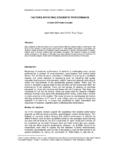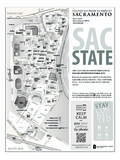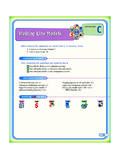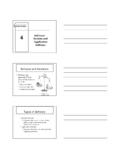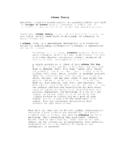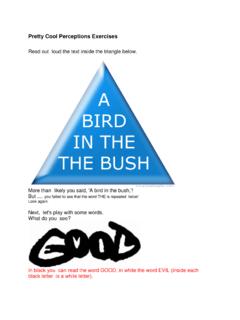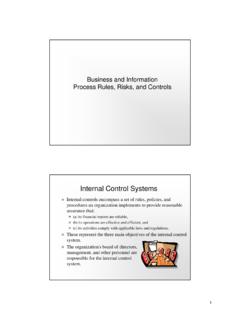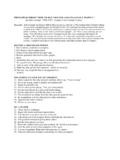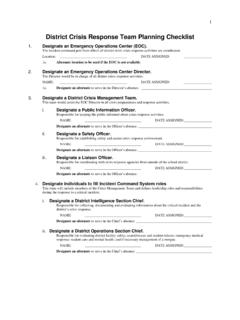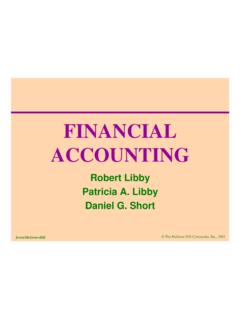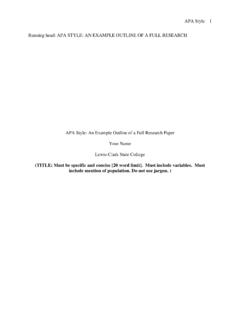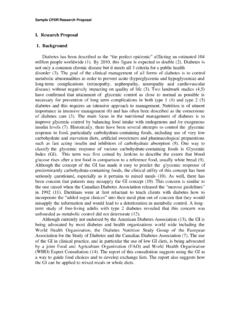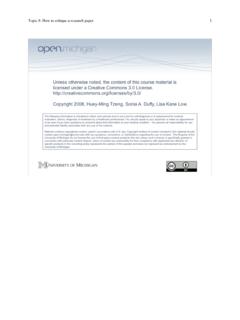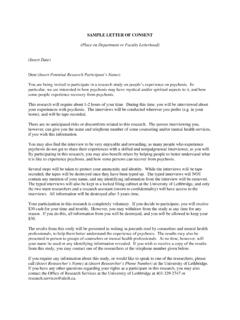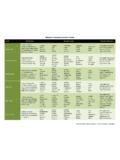Transcription of Types of Group Comparison Research
1 Stephen E. Brock, , NCSPEDS 250 Causal-Comparative Research11 Causal-Comparative Research &Single Subject ResearchStephen E. Brock, , NCSP California State University, Sacramento2 Correlation vs. Group ComparisonCorrelationalGroup Comparison1group2or more groups 2or more variables1independent variableExtent to which 2 or more variables are relatedto each otherExtent to which 2 or more groups are differentfrom each otherIdentifies relationshipsamong variablesMakes comparisonsbetween groups3 Types of Group Comparison ResearchCausal-comparative AKA Ex Post Facto (Latin for after the fact). Researcher does not form the groups. Groups to be compared are formed before the study begins. A pre-existing variable defines the Experiment Researcher forms the groups.
2 Groups to be compared are not formed before the study begins. Individuals are not randomly assigned. Intact groups are randomly assigned to a treatment Experiment Researcher forms the groups. Groups to be compared are not formed before the study begins. Individuals are randomly E. Brock, , NCSPEDS 250 Causal-Comparative Research24 Portfolio Activity #8 Mini-proposal 3 Briefly describe a causal-comparative Research project relevant to one of your identified Research topics. In small groups discuss your mini-proposal ideas and be prepared to share your discussions with the rest of the class5 Causal-Comparative ResearchGroups defined by difference on some pre-existingvariable (the independent variable). Causal Comparative - Group difference(s) exist(s) before the study begins ( , SES, Gender, ADHD).
3 Group membership is the independent variable Experiment - Group difference(s) are assigned by the researcher ( , type of instruction, an approach to counseling). Group differences do not exist before the study begins6 Causal-Comparative ResearchThe question being asked is whether, and to what degree, groups also differ on another variable (the dependent variable or measure). Causal Comparative - Do children from high SES (IV) backgrounds attain higher achievement levels (DV) than children from low SES backgrounds? Experiment - Do children who learn to read via Reading Mastery (IV) attain higher achievement levels (DV) than children who learn to read via a whole language approach? would make this Experiment a Causal Comparative study ? might an educational researcher want to make this into such a study ( , turn it into a causal comparative study )?
4 Stephen E. Brock, , NCSPEDS 250 Causal-Comparative Research37 Reasons for Employing a Causal-Comparative ApproachCausal-Comparative methods are typicallyused because the variable under study (the IV).. cannot be directly manipulated. Gender Age Others? should not be manipulated. Destructive habits Disease or disorder Others?Why else would a causal-comparative method be used????8 Reasons for Employing a Causal-Comparative ApproachThese methods are also sometimes used to help determine if the more complicated and expensive experimental design is worthwhile. Did our prior discussion identify this as a possible reasons for conducting a Causal-Comparative study of Reading Mastery?9 Variables Often Examined in Causal-Comparative StudiesInternal Organismic Ability Personal CharacteristicExternal Family-related School-relatedIdentify examples in each of these five would be the IV in a causal-comparative studyStephen E.
5 Brock, , NCSPEDS 250 Causal-Comparative Research410 The Two Basic Research DesignsSymbols:E = Experimental groupC = Comparison groupX = independent variableO = Dependent variableGroupIVDVCase AEXOCXOCase BEX1 OEX2O11 Control ProceduresIn an ex post facto study , it is difficult to make conclusions about a causal relationship between two variables. One cannot be sure that the two groups do not differ with respect to variables other than the variable under to consider the possibility that dependent measure changes (results) are due to factors other than the independent variable ( Group membership). 12 Control ProceduresSometimes you are aware of these alternative explanations for Group differences before you begin a study . For example, in my study of the effect of ADHD on reading comprehension I was aware that ADHD often co-exists with reading disabilities.
6 The presence of ADHD children with reading disabilities in my sample would have been a confounding variable. Stephen E. Brock, , NCSPEDS 250 Causal-Comparative Research513 Control Procedures Confounding Variables Any variable on which groups in an experimentsystematically differ, other than the variable whoseeffect the Research is interested in determining, is aconfounding variable (Crowl, 1996, p. 274).Because of its inability to randomly assign participants, confounds are especially problematic when conducting an ex post facto study . The random assignment of an experiment minimizes such confounding ADHD Associated with Relative Reading Comprehension Difficulties?ADHDIV - Group membershipNo ADHDPoor rding. -Test ResultsRelatively high rding. SLDC onfound10% SLDHow might a causal-comparative study attempt to address this confound?
7 15Do learning disabilities cause low self concepts?LDIV - Group membershipNo LDPoor self-conceptDV -Test ResultsRelatively high outLow tchr. ExpectationsTeasedConfoundsNot pulled outHigh tchr. ExpectationsNot teasedHow might a causal-comparative study attempt to address these confounds?Stephen E. Brock, , NCSPEDS 250 Causal-Comparative Research616 Sample Selection Control ProceduresMatched PairDesign Systematically select participant pairs who are similar in all important ways other than the independent GroupingDesign With the exception of the independent variable ( Group membership) make sure that participants in both groups are very similar in all important Analysis Control ProceduresFactorial analysis of variance. A statistical way to assess the effects of potential confounds on the dependent measure.
8 Analysis of Covariance Adjusts scores on the dependent variable for initial differences on some other variable related to the dependent Score110XO112O18 Data AnalysisDescriptive Statistics Mean Standard DeviationInferential Statistics t-test The difference between 2 dependent measure means ANOVA The difference between 3 or more dependent measure means Chi Square The difference between the frequency of occurrence of the dependent E. Brock, , NCSPEDS 250 Causal-Comparative Research719 Single Subject Research ..involves multiple measurements of the behavior of a single individual at different points in time prior to, during, and following the use of some intervention designed to change the individual s behavior (Crowl, 1996, p. 324).Differs from case studies in that this Research attempts to control some aspect of the environment.
9 20 Single Subject ResearchThe objective is to determine if an intervention has significantly affected the behavior of the previously discussed observational strategies are often used to provide the data to be design used in FAAs and in RTI See handout for an example of a Single subject Research / RtI data Subject ResearchSingle-Subject versus Group Designs Unlike an experiment there is no control Group in single-subject researchValidity determined Repeated and consistent measurement Baseline stability The single variable ruleStephen E. Brock, , NCSPEDS 250 Causal-Comparative Research822 Types of Single Subject ResearchA-B-A WithdrawalMultiple BaselinesAlternating Treatments23A-B-A WithdrawalA-B DesignA-B-A DesignO O O O OBaseline PhaseAX O X O X OTreatment PhaseBO O O O OBaseline PhaseAX O X O X OTreatment PhaseBO O O O OBaseline PhaseANOTE: O = measurement, X = treatments24A-B-A-B DesignSee handoutStephen E.
10 Brock, , NCSPEDS 250 Causal-Comparative Research925 Multiple BaselineEmployed when it is impossible to return to the baseline ( , the intervention has resulted in permanent change in behavior), or when there are several interventions to be implemented26 Alternating TreatmentsThe Alternating Treatments Designis used to directly compare the effects of two or more different experimental variables across the same span of time in the same subject. Effective in controlling for systematic changes in the subject or setting across time. Disadvantages inability to deal with irreversible effects potential generalization from one condition to the other interpretation problems due a variety of interactions, carryover, and order effects. 27 Single Subject ResearchCREATING SINGLE-SUBJECT DESIGN GRAPHS WITH MICROSOFT EXCEL by James E.
